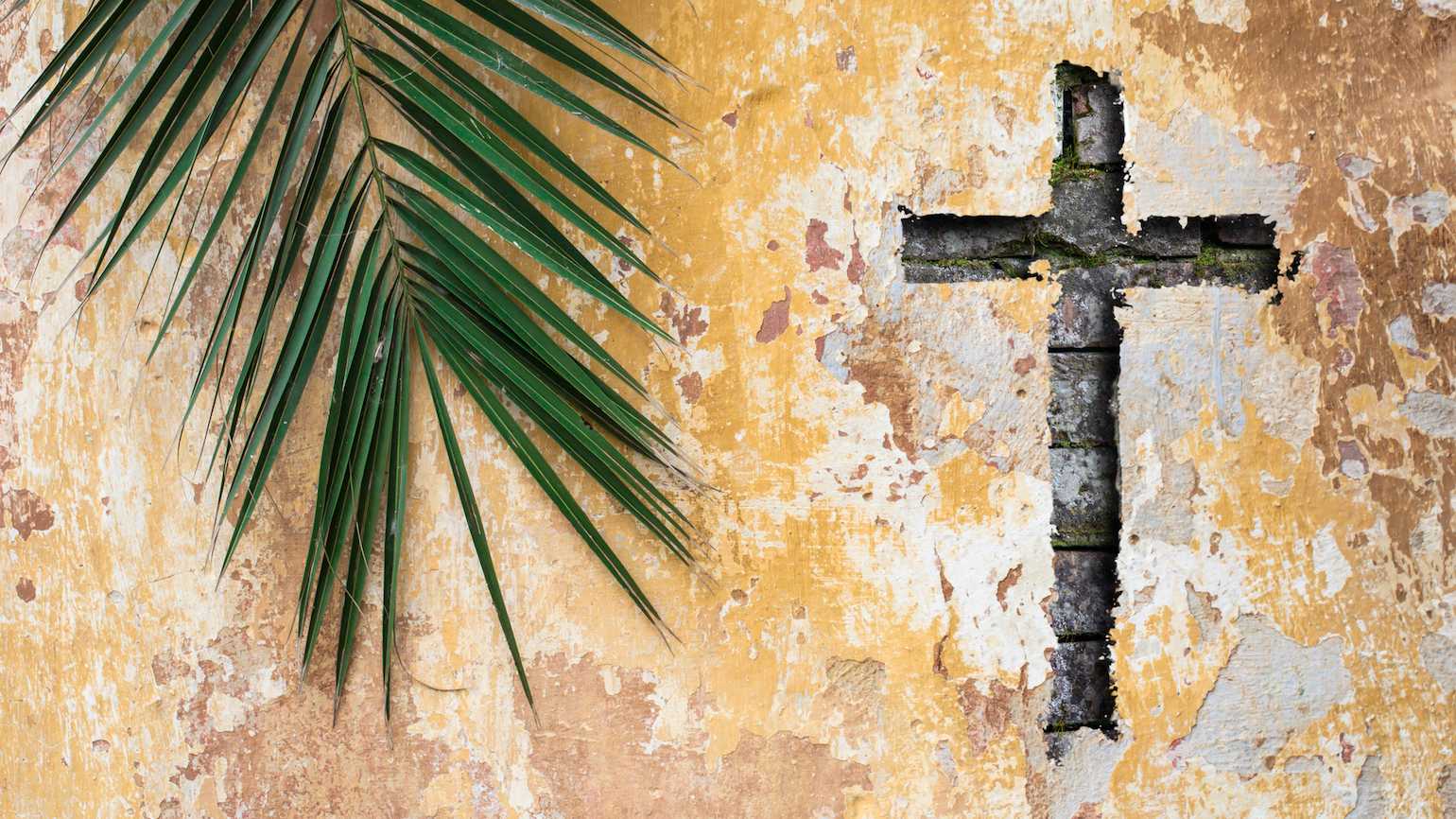
With a snap of our fingers, the Christian Lenten journey is coming to an end as Holy Week is quickly approaching. This time of solemnity that is remembered between Palm Sunday (April 10th) and Easter morning (April 17th) is meant to be a time where we journey with Christ through the final moments of his earthly ministry.
Holy Week begins with Palm Sunday and the celebration of Jesus’ triumphal entry into Jerusalem. Both disciples and onlookers alike celebrated his final return to the holy city. Waving palm branches and laying their cloak on the ground, the crowds gathered there that day and showed their respect and praise for Christ. On Palm Sunday, Christians imitate this ancient tradition as we too wave palm branches and sing “All Glory, Laud, and Honor” in celebration of the fateful journey Christ made for us into the walls of the city one final time.
The week continues with Holy Monday, Tuesday, and Wednesday. This year on these days, we keep in mind the lessons offered as Jesus curses the fig tree, cleanses the Temple, and confronts the authorities. Maundy Thursday marks the beginning of what we in the church call the Paschal Triduum or the Three Days. On this day of worship, we gather and hear the story of Jesus’ final night with his disciples before he is arrested. We are reminded of the selfless example of love and service Jesus shares with his disciples as he kneels before them washing their feet and shares one final meal together. It is custom that we, too, wash one another’s feet on this night, but with COVID, there will be other ways that we remember and celebrate this practice. The evening concludes with the stripping of the altar, lectern, and pulpit as a symbol of Christ’s impending suffering and death.
On Good Friday, we gather in silence. We come together to partake in the Tenebrae Service or Service of Darkness. On this night, we hear the account of Jesus’ final hours – his trial before Pilate, his mockery and abuse at the hands of the guards, his journey to Golgotha, and his last painful moments on the cross. We are left, like the first disciples, with immense heartache. Wanting to know what’s next, where do we go from here. We depart that night in the same way we arrived – in silence. We are left reflecting on the ultimate sacrifice Christ gave for us.
We prepare to conclude our Holy Week observances with the observance of Holy Saturday. On this final day before Easter, we wait in hopeful anticipation. The celebration of this day is practiced in many ways across the church, but at Redeemer, we will gather early Saturday morning and while carrying the cross through our town, we practice the Stations of the Cross and remember the journey Christ took for us.
Holy Week concludes with the joyous, magnificent, and marvelous celebration of Easter! We sing and say with our voices raised – Christ is Risen, He has Risen Indeed! We gather and celebrate that Christ overcame death and the grave and offered for all the promise of life eternal! Most local Christian churches have websites and/or Facebook pages where one can find announcements about plans for Easter worship. Please check announcements, bulletins, and website for more details on each.
This blog post is the expressed opinion of its writer and does not necessarily reflect the views of Tysons Interfaith or its members.
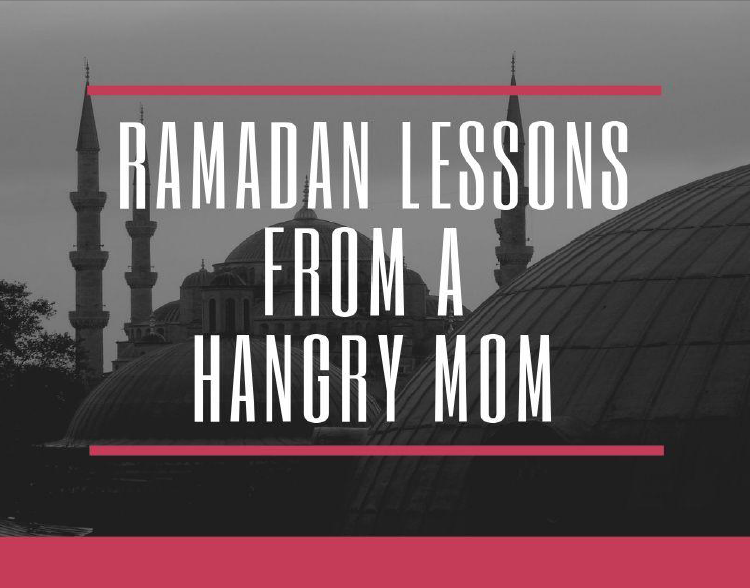
Ramadan is expected to begin at sundown on Friday, April 2. To our Muslim friends, we say, “Ramadan Murbarak.” And we bring to you, with our gratitude, this blog post written by Zaiba Hasan of the McLean Islamic Center:
It is almost the holy month of Ramadan, and I have a confession to make to you all – I am not the best fasting person. I really feel like I am Zombie Zaiba all day. Someone permanently hangry, if you will. I am not proud of this title but in an effort to be authentic I try to share the good, the bad, the ugly.
Ramadan for me has always been a mixed bag. I feel excitement along with trepidation mixed with anxiety for weeks before the holy month begins. My children start talking in hushed whispers –fasting mama is coming, with slight fear in their eyes. However, in an attempt to fix my attitude I want to focus on five lessons I have learned during this holy month, and that I hope to carry lessons with me for the remainder of the year. I pray – especially if fasting (and all that goes with it) isn’t easy for you either – that these lessons help you stay the course during the Ramadan and beyond.
Family: Nothing brings a family together faster than saying, “It’s almost Maghreb.[1]” My house sounds like a herd of elephants stampeding through the jungle before I can even get that last word out. As we sit around the table, in our dazed, hungered state, we share stories about the day, laugh at silly jokes my second grader loves to tell, and talk about some of the issues going on in the world today. I realize in our crazy schedule of work, school, practices, homework – we don’t do enough family dinners. My hope for when Ramadan ends is that we can continue to take a break from our hectic lives and make a point to connect as a family around the dinner table and in other ways.
Gratitude: Nothing gives you the most sense of gratitude then that first drink of ice cold water at sunset after you’ve been sitting outside in 90 degree weather at your son’s baseball game for three hours. After a long day of fasting I have the luxury of being able to break my fast with a delicious meal, a beautiful roof over my head, surrounded by the people I love most in this world.
The fact that two percent of the world’s population are homeless and close to 20 percent lack adequate housing isn’t lost to me and as I take that first sip of water. I am forever grateful that I am able to break that fast when others don’t know where their next meal is coming from. We all, those of us privileged to be able to break our fast with adequate food and drink and enjoy shelter, cannot be grateful enough.
Charity: The definition of fasting really means to abstain or to do without. Nothing heightens your sense of giving than to feel physically what it is like to do without. During the month of Ramadan more people are apt to donate their zakat [2] or give sadaqa [3] since this is the month of fasting, prayer and charity. However, why only give in Ramadan, or only give as generously as you do during this holy month? The act of charity should continue into the rest of the year. Whether you are donating your dollars or time, it never hurts to give to others. (Here are nine charities you can support in Ramadan and beyond through your volunteer hours, with monetary donations or both. Still looking for a good charity? Here are eight more!)
Prayer: I have another admission to make. I am not the best at prayer. I do them quickly or sometimes forget to do them at all. (I know. This is terrible). However, Ramadan brings a new sense of spirituality and connection to something bigger than myself. When you feel the pangs of hunger and thirst, it is a physical reminder of your devotion to something bigger than yourself. To take the time out of our crazy days to stop and take a break for salah, means to take a breather, have a conversation with God and readjust our attitudes to the world around us. If I can continue to do this with regularity and focus, I feel like I can only benefit from this the rest of the year.
(Here are four ways to get better about your five daily prayers and other simple spiritual goals to center in Ramadan and beyond.)
Patience: Part of my personal mission this year was to maintain my patience when my patience was at its thinnest. When your head is pounding from lack of caffeine and your children (or hubby) are grating on your nerves, it’s easy to yell out in frustration. My goal this Ramadan was to limit those outbursts as much as I could. To not let my hangry self lash out at the others around me. Like my daughter loves to tell me, “You are a grumpy fasting person.” Ouch, but it’s true. I will instead focus on gratitude, charity, prayer, and patience for the rest of the year and if God allows me to see another Ramadan, my hope is to be a better person than I am today. Until next time….
This blog post is the expressed opinion of its writer and does not necessarily reflect the views of Tysons Interfaith or its members.
[1] The evening prayer that marks the end of the fasting day
[2] za·kat /zəˈkät/ noun obligatory payment made annually under Islamic law on certain kinds of property and used for charitable and religious purpose.
[3] Sadaqah or Sadaka (Arabic: صدقة ,IPA: [sˤɑdæqɐ], “charity”, “benevolence”, plural ṣadaqāt صدقات( in the modern context has come to signify “voluntary charity”. According to the Quran, the word means voluntary offering, whose amount is at the will of the “benefactor”.
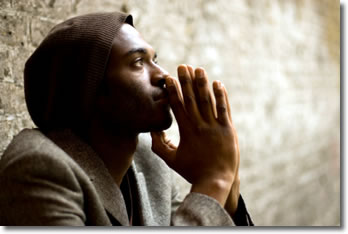
You are invited to “Pause for Peace” … to cause a “spiritual chain reaction!”
Just imagine if you invited everyone you know to invite everyone they know to “Pause for Peace” … just stop what they are doing for maybe 1 or 2 minutes (or more if they choose) and consciously choose to be peace. Their worlds will be transformed, and in the process, our whole world will experience a shift. Peace will prevail.
Our congregation at the Center for Spiritual Living Metro has chosen 12:00 noon each day plus any other time that the thought occurs, just “Pause for Peace.”
In addition, Tysons Interfaith invites you to immerse yourself for an hour in prayers and meditations for Peace from an array of traditions. This event will take place virtually on Sunday, April 3 beginning at 4:00 pm. To register, please visit: eventbrite.com
We hope you will join us as collectively we raise the consciousness of the world to Peace.
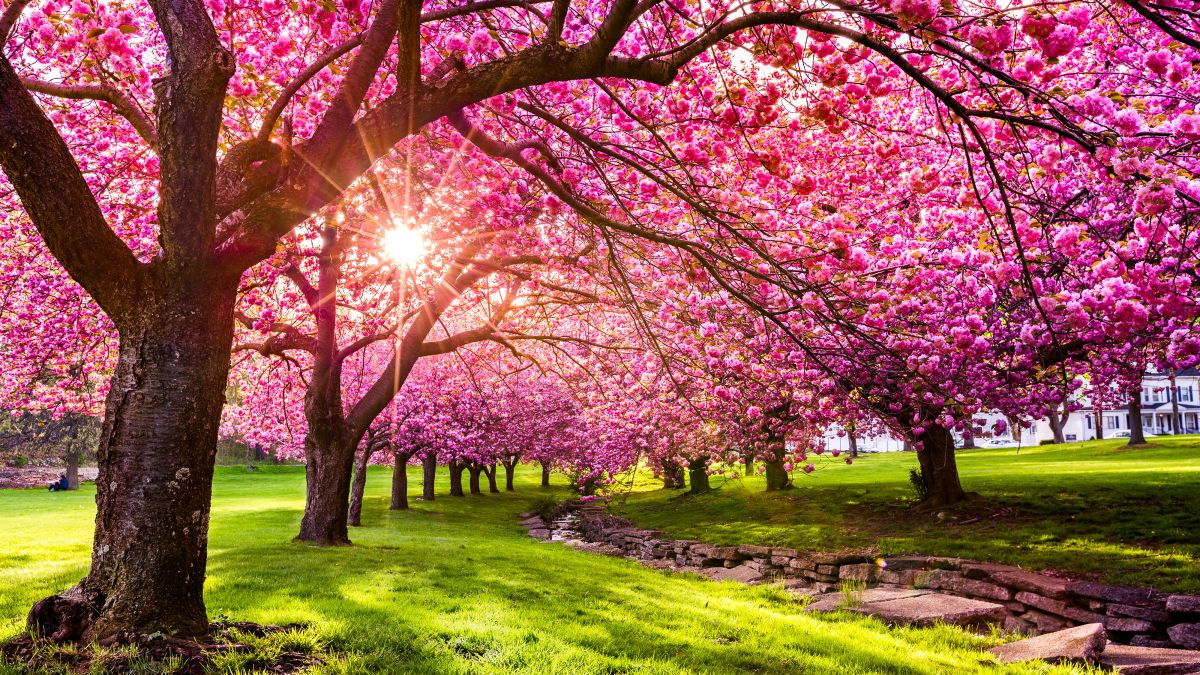
As we approach Holy Days in the Baha’i faith, we invite you to enjoy this repost of a blog from last spring:
Probably many people know that Easter and Passover occur in the spring, but spring is also a time of sacred observation for people of the Baha’i Faith.
March 20- 21 are the Baha’i Holy Days of Naw-Ruz, the Baha’i New Year.
Naw-Ruz coincides with the spring equinox and is an ancient Persian festival celebrating the “new day.” For Baha’is it marks the end of the annual nineteen-day fast and is one of the nine holy days of the year when work is suspended, and children are exempted from attending school.
Also in the spring is the Festival of Ridvan. This annual Baha’i festival commemorates the twelve days when Baha’u’llah, the founder of the Baha’i Faith, publicly proclaimed His mission as God’s messenger for this age. Elections for local, national, and international Baha’i institutions are generally held during the Festival of Ridvan. The first day (April 20 or 21), the ninth day (April 28 or 28), and the twelfth day (May 1 or 2) are celebrated as holy days when work is suspended, and children are exempted from attending school.
To learn more about the Baha’i Faith, please visit: https://www.bahai.org/
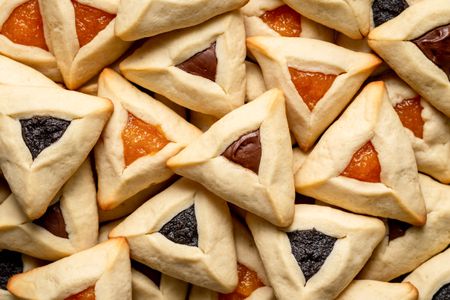
Next to Chanukah, Purim is probably the holiday to which Jewish children can most relate. There are costumes, carnivals and Hamentaschen (preserve filled cookies in the shape of a triangle). When the story is told, they get to make lots and lots of noise with groggers (twirling noise makers) in hand. But surely there is more to the holiday than that.
In the Hebrew bible, in Kethuvim (the Writings), appears the Book of Esther or Megillat Esther. In this short book, the story is related about a Persian king, who by historic timing might have been Xerxes I or Artaxerxes I. His first wife has the audacity to disobey him and she is banished. A call is put forth for a new wife and fair women from throughout the kingdom vie for this opportunity. Among them is Esther, a Jew. She wins the contest, but never reveals her background.
Concurrent with the wife plot is the plot of Haman who hates the Jews. Like generations before and after him, he couches his hatred by saying “There is a certain people, scattered and dispersed among the other peoples in all the provinces in your realm, whose laws are different from those of any other people and who do not obey the king’s laws; and it is not in Your Majesty’s interest to tolerate them”. (Esther 3:8).
Esther, from her position within, takes the risk of revealing her Jewishness to the king, and then exposes Haman’s plan to destroy her and her people. The king cancels Haman’s plans and Haman is executed.
Purim, like Chanukah, is traditionally viewed as a minor festival, but elevated to major holiday status as a result of the Jewish historical experience. Over the centuries, Haman became the embodiment of every antisemitic leader in every land where Jews were oppressed. The significance of Purim lies not so much in how it began, but in what it has become: a thankful and joyous affirmation of Jewish survival against all odds.
This blog post is the expressed opinion of its writer and does not necessarily reflect the views of Tysons Interfaith or its members.
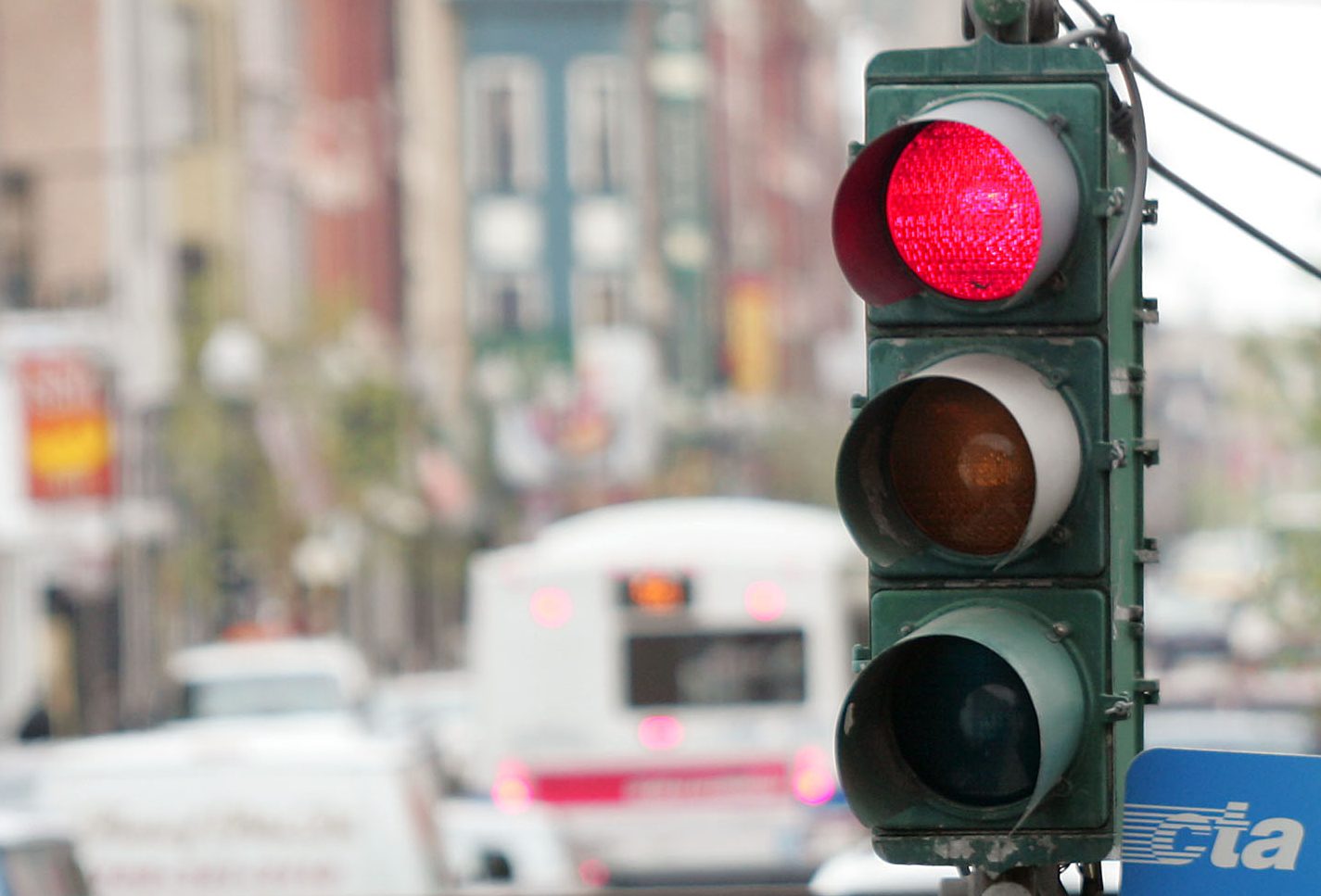
While serving at a church in Pennsylvania, I got stuck at a light on my way to the joint Ash Wednesday worship with the neighboring Episcopal Church. And I mean stuck. As the stop lights cycled multiple times through for everyone else, the light in my lane remained red. Just as I was about to do something I shouldn’t, the light finally turned green, and I arrived right on time.
Ash Wednesday, as the start of Lent, is like that. Ready or not, it’s time to pause and make note of the brake lights and the stop lights. Ready or not, it’s time to travel through the wilderness, take the slow lane or even a different route, knowing that in forty days (minus Sundays), we will still arrive right on time, exactly where we need to be.
The Christian season of Lent begins on Ash Wednesday and ends on Easter Sunday. It is a season of prayer, introspection, and for some, fasting or giving up of certain earthly pleasures. During Lent, Christians reflect on events of the life of Christ leading up to and including his death and resurrection. Forty days of penitent reflection is indeed inspired by the Jesus’s own forty-day experience in the wilderness, accounts of which are found in the books of Matthew, Mark and Luke.
Now we may not find ourselves led out into the wilderness by the Holy Spirit this Lent, as Jesus did. We may not face a talking serpent or the devil face to face. But in the wildernesses that we find ourselves in, be they physical, emotional, or spiritual, we too find our identity tested. We are constantly tempted into thinking that, as we are right now, we are not good enough to be children of God.
Most of us are aware of our limitations and our hang-ups, and the tempter takes every opportunity to remind us of where we fall short. But from my faith perspective, Lent is not for sacrificial self-improvement to be more holy come Easter Sunday. Lent instead takes us through the wilderness to reflect on our own shortcomings, in order to remind us to let God be God. Not so that we can feel guilty at where we fail. But so that we can get out of our own way and be nothing less than members of God’s family. Anecdotally, when Martin Luther felt tempted by the devil to despair, he would shout in response, “I am baptized!” Not “I was”, but “I am.” Present tenses. True in this very moment.
The trip through Lent every year takes us from a garden to a wilderness and back again, from human sin and transgression and death to resurrection, from the ash crosses of Ash Wednesday to the shadow of the cross on Good Friday, through the Garden of Eden, to the garden of Gethsemane, to the garden that contained Jesus’ empty tomb. Every year, we tell the story, to remind ourselves who we are and who we belong to. “I am baptized.” Present tense.
We Christians wear the sign of the cross in ashes on the outside to remind ourselves of the work that God is enacting on the inside of us. The confessing of our sins. The embracing of our brokenness. The naming of our grief and disappointments. And this the slow and painful process of the transforming of our dusty and broken hearts into clean ones, better able to love the other dusty hearts out there in our lives and in the rest of the world. That transformation probably takes more than forty days. But forty days is a good start.
.

Back in October of 2021, a post floated around social media professing that “you can’t worship from your couch.” This generated a mild sensation among pastors who serve churches taking full advantage of online ways to be “church.” Fast forward to the present, and yet again the internet is buzzing with a similar dismissal of on-line worship, this time in the form of an ableist and dismissive opinion piece from the New York Times. In this article, already limited in its accessibility behind a paywall, the pastor claims that with the pandemic being “managed” with masks, distancing, and a milder variant, all churches (and communities of faith perhaps) should stop online options to primarily focus back on physical gatherings. Yes, we have yet another iteration of the “you can’t worship from the couch” fallacy.
I shared my thoughts on Facebook in October, and these words seem just as relevant now: As church attendance again (and AGAIN) becomes a hot topic in our nation, and online services have become a vital part of FINALLY including an underserved people, it’s important to remember why community is important in ALL the ways that you and your family are able to connect, no matter the type of community you are part of.
As members of my own community have shared with me – while you may not be able to pack meals from your couch if you struggle with a chronic illness… you can sing and pray while worship is streaming. You CAN be surrounded by your community of faith if you are unable to get out of bed that day. You CAN still experience the power of God’s presence, even if you aren’t able to be with everyone together on your day of worship because of illness, the children are vomiting all over the couch, your anxiety or depression are keeping you to your couch, or your autistic child is having a hard day and the couch is a safe place for them.
People need community, and community comes in many forms. We can contribute letters and cards and Facebook posts and prayer requests and email encouragement and tithe from literally ANYWHERE now. We can serve, sacrifice, encourage, pray, and do life together both online and in person. And actually, many of us have already been doing it for years already. For my siblings in Christian communities, I hope that we will continue to use all available tools to meet people where they are in their lives, as a way to recognize their true value and extend real welcome. Online options are here to stay, and this is a blessing from God.
We can’t be all things to all people. But as people of faith, we believe our call is to meet and love people, in all the miraculous ways we can be embodied together, however we can. Holy, sacred community cannot be contained by four walls, for one hour per week. One can experience this on the internet, from your couch, and sometimes even in pajamas, at all hours of the day and night.
If it happens that the New York Times does not renounce or at least allow a rebuttal to the above-mentioned article, may I be so bold as to suggest some future answers to Wordle, the famous 5-letter word game they recently acquired. I, among others, have noticed some words that seem to be lacking, such as: world, agape, boost, links, pivot, and unite. Especially when so many communities of faith are, miraculously, getting this right.
This blog post is the expressed opinion of its writer and does not necessarily reflect the views of Tysons Interfaith or its members.
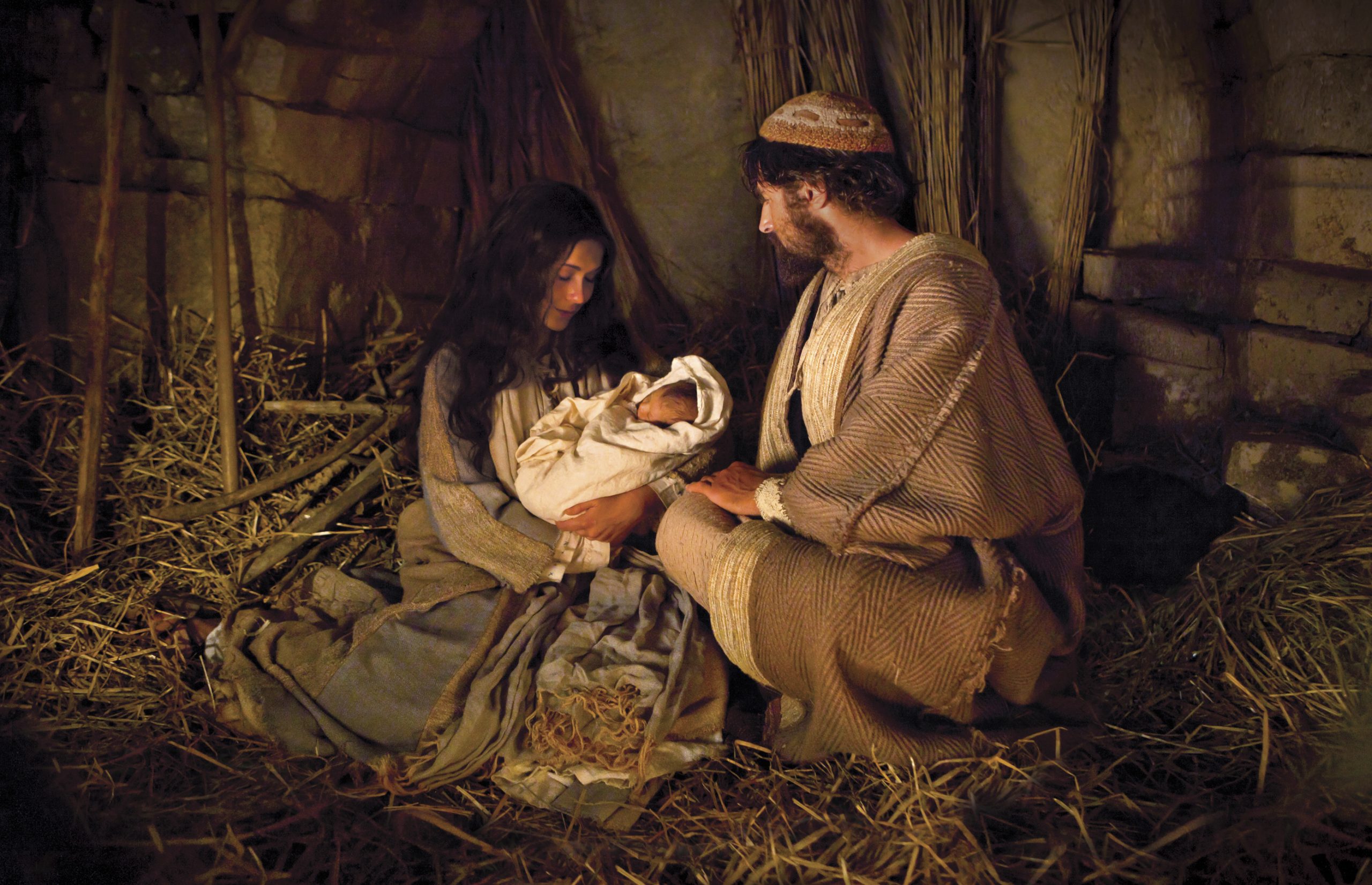
My husband David and I are the proud grandparents of six wonderful grandchildren. Our youngest granddaughter was born seven years ago on December 21st. She wasn’t expected until mid-January, so her pre-Christmas arrival was a surprise to everyone. We received our first picture of that tiny, beautiful, newborn baby the next day. She was so tiny. And so vulnerable.
Her first photo arrived as I was writing my Christmas Eve sermon. I was immersed in the story of the Roman Emperor, Augustus and how that emperor’s story intersected with that of the child born in Bethlehem so long ago. Augustus also claimed to be the son of God. And in all of his actions, including the ones described in the Gospel of Luke, chapter 2, verses 1-20 he’s much more interested in amassing power and wealth than he is in caring for the people around him.
I was struck at that moment, as I have been struck every year since then, of the amazing thing that God did on that first Christmas. One of the words given to the baby born on Christmas Day is Emmanuel. It means God-With-Us. Christians believe that God came among us, as one of us, in the person of Jesus of Nazareth. And when God came into the world, he didn’t come as a powerful emperor. Instead, he came as a vulnerable, newborn, human baby.
Imagine any newborn you’ve encountered. And now, compare that tiny vulnerable human with images of reliefs that depict imperial power in this temple, the Sebasteion in what was then Aphrodisias. If you click here, you can see various reliefs showing Roman emperors subjugating those Rome has conquered, including a woman personifying Britannia being dragged around by her hair!
For me, as a Christian, that is the true miracle of Christmas. When God came among us, as one of us, God did so in a way that was a sharp contrast to worldly power. God didn’t come as a powerful emperor. God didn’t come in a palace. God didn’t even come as an adult human. Nope! When God came among us as one of us God came as a vulnerable little baby, born to a poor family, in a town with some theological significance (Bethlehem was the city of David) but which wasn’t a booming metropolis.
Throughout scripture, God stands with those who are poor, hungry, oppressed, and vulnerable. And in case we missed it, God does the same thing when God comes among us as Emmanuel. That is something worth celebrating!
Blessings to all!
This blog post is the expressed opinion of its writer and does not necessarily reflect the views of Tysons Interfaith or its members.
Well, it is the season, the season for Christmas music! Love them or hate them, these familiar tunes fill the air during this joyous time. One does not have to look hard to find them either; it seems that many of our local radio stations started playing these songs even before Thanksgiving! You hear of white Christmas’ and stars dancing across the sky, but my favorite nonchurch hymn is “Jolly Old Saint Nicholas.” You know the tune, “Jolly old Saint Nicholas, lean your ear this way, don’t you tell a single soul what I’m going to say…” This song reminds us of the fun of Christmas – Santa Claus, gifts, and family. As pastors (at least in my tradition), we try to keep the two separate: Christmas in its true sense and the coming of Jesus the Christ child, and that of Santa Claus and his reindeer’s in the secular/ commercial sense. But believe it or not, there is a lot that we can learn from jolly old Saint Nick.
Now St. Nicholas was not always St. Nicholas. Born Nicholas of Bari in the early third century, he grew up in what is now modern-day Turkey. Raised in a Christian home, he was a person of devout faith in Christ. Nicholas lived out his faith in all that he did and held strong to it after losing his parents as a young man. Legend has it that rather than taking his inheritance and spending it on himself, he devoted his life to the poor and less fortunate in his community. Leaving small bags of coins on the doorsteps of those in need, Nicholas worked to ensure people, especially children had the necessities of life. One story tells of Nicholas caring for a family who was being forced to give their children into servanthood, but rather than seeing this family torn apart, Nicholas paid the debts that were owed. Again, leaving three small sacks of money over the course of three nights, one for each of the children, Nicholas ensured this family would remain together.
Nicholas went on to become Bishop of the Christian churches of Myra in Asia Minor and continued to do many great things for the good of God’s people. His reputation and example of selflessness for children and the poor lived on long after his death. So much so that he was canonized in the early fifteenth century, and his feast day is celebrated by many of the mainline denominations today. On this day, we are invited to place our stockings or shoes by the door in hopes of finding a few gold coins left there the next morning (chocolate ones, of course).
During this holiday season, St. Nicholas offers us the perfect example of how to enter this festive time. No matter our faith tradition – rather than simply marking the days off the calendar, waiting for Christmas to finally come. Jolly old Saint Nick reminds us to actively wait by caring for all God’s people in need.
This blog post is the expressed opinion of its writer and does not necessarily reflect the views of Tysons Interfaith or its members.
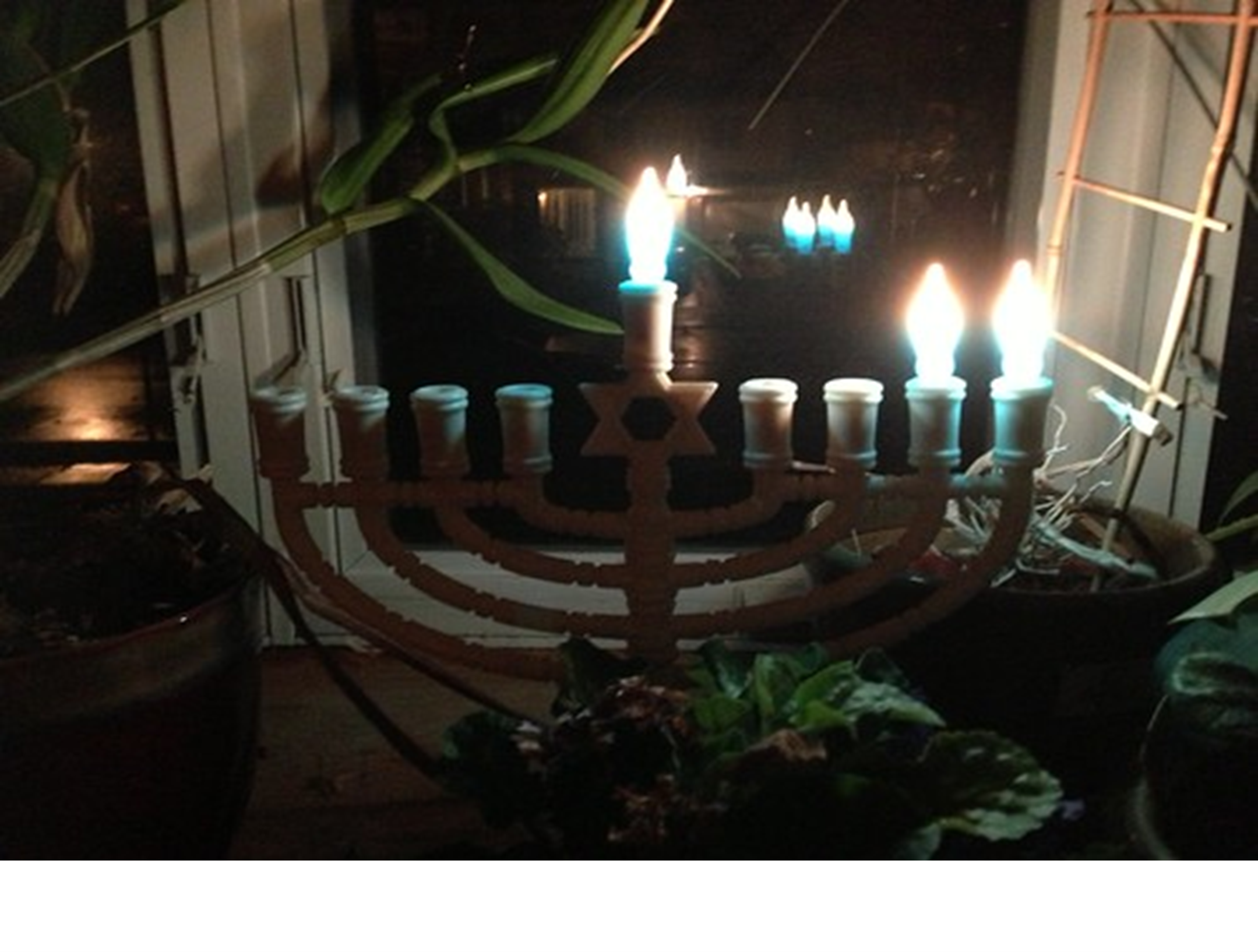
Chanukah, or Hanukah or any of 14 other ways to spell it (because they are all transliterations from the Hebrew), is a Jewish winter holiday. This is intentionally very vague, because there is so much more to explain.
First, what Chanukah is not. It is not the Jewish Christmas. Although it became widely celebrated in the late 1800’s due to its proximity to Christmas, this holiday is really a minor holiday, coming from the Book of Maccabees which didn’t make it to the Jewish Bible (Tanakh). The Book of Maccabees is one of the 14 books in the Apocrypha, from the Greek word meaning “hidden”. Scholars are still arguing about why it was left out, two possible reasons were that it was too new (written near the end of the 2nd century BCE), another that it wasn’t politically correct; fearing the alienation of the Romans with a story of the Jews who fought and beat another ruling power. And, that is what the holiday is all about. The Maccabees fought the Seleucids for freedom of religion, and won.
To celebrate the victory, the Jews went to rededicate the temple in Jerusalem which had been taken over by the Seleucids and defiled. The anniversary of this rededication is how the date for the Chanukah celebration was determined. Chanukah is always on the 25th of the Hebrew month of Kislev, which is on a different calendar system than the one we use. This means that the actual date for the beginning of Chanukah on the Gregorian calendar changes every year and can be as early as November 28th, as it is this year, or be as late as December 25th, which will happen in 2024.
Another name for Chanukah is the Festival of Lights. The story is that when the temple was finally cleansed, they found only enough oil to last one night, but by a miracle, it lasted for eight, and that is the reason for eight days of Chanukah.
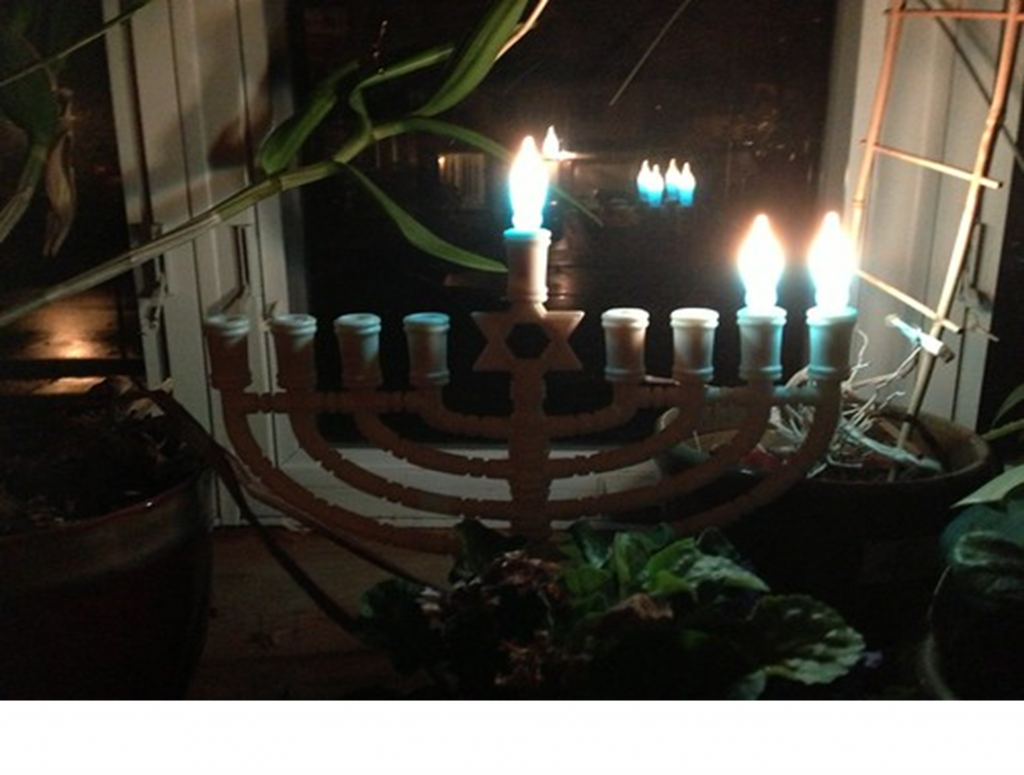
Like all holidays and festivals, traditions abound and they can be different in different parts of the world. Fairly universal are the following: lighting the Menorah (officially called a Hanukiah), starting with one candle the first night, lighting two the second night, etc.; eating foods that have been fried in oil such as potato latkes here, jelly donuts in Israel; giving gifts, traditionally gelt, the German and Yiddish word for money; and playing a game with a four-sided spinning top called a dreidel.
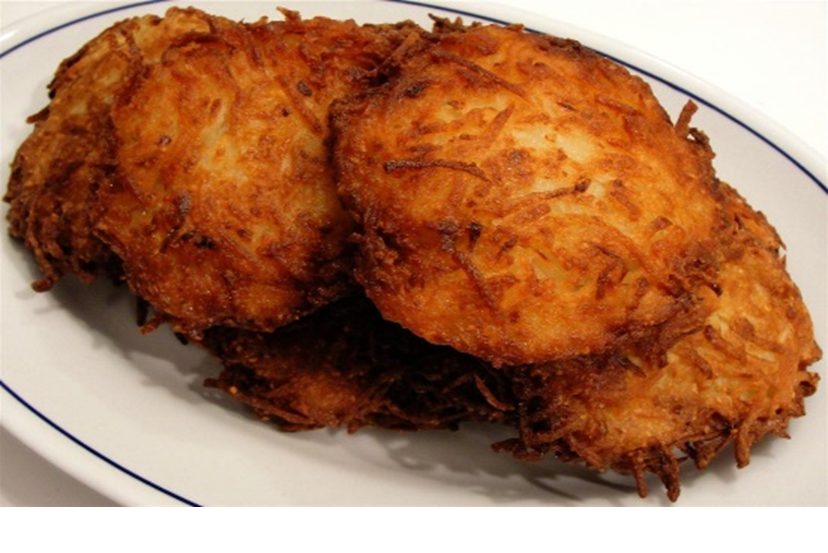

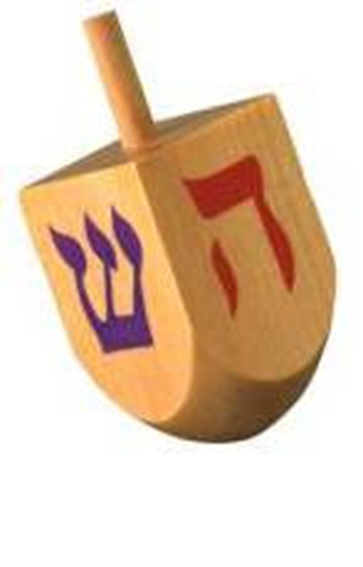
The lighting of the menorah in public goes back to the beginning of the holiday itself. The sages instructed that the menorah be lit at the entrance to one’s home to publicize the miracle.
Chanukah was first celebrated in the White House by President Truman in 1951 when Israel’s Prime Minister, David Ben Gurion presented him with a Hanukiah. It has been celebrated by every president since then. In modern times, lighting of the public menorahs started in 1974 in Philadelphia at the foot of the Liberty Bell. The largest Hanukiah in the world is in Grand Army Plaza in New York City. It is 32 feet tall and weighs 4000 pounds.
This blog post is the expressed opinion of its writer and does not necessarily reflect the views of Tysons Interfaith or its members.
